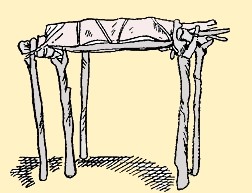

Patrocinio del
Comune di Roma
Dipartimento XIV
Comune di Roma
Dipartimento XIV
ancestor worship and socialization of the dead Lazarovici and mine working hypothesis is that the charred-like colour of the bones and the "exploded" appearance of some part of them are due not only to the soil but also to their decarnation. We don't think that a body preparation happened as an excarnation by processor corpse dismemberment, [24] because we didn't find any clear sign of knife, razor, blade, bird beak or claw or animal fang. The act of depriving or divesting of flesh was made by the simple decomposition of the body on the first (primary) burial stage or exposing it to natural events. Anyway, in this phase of the research we can't exclude a very delicate mechanical bone cleaning of soft tissues, using for example fingernails as the tribe Chokta did in North America. [25] 
 Following
our working hypothesis, the Tărtăria pit would be evidence
of a secondary burial. Did a double funeral rite happen with the
reburial of disarticulated skeletal remains? Following
our working hypothesis, the Tărtăria pit would be evidence
of a secondary burial. Did a double funeral rite happen with the
reburial of disarticulated skeletal remains? If one follows the Krum Buchvarov's suggestions about Bulgarian Neolithic on the ultimate secondary burial as conclusion of a two-stage process of post-mortem body treatment, the Tărtăria reburial was based on some kind of rite of initiation. [26] Maybe it was associated with ancestor worship and socialization of the dead. | |
merlini tartaria | 1 | 2 | 3 | 4 | 5 | 6 | 7 | 8 | 9 | 10 | 11 | 12 | 13 | 14 | 15 | |